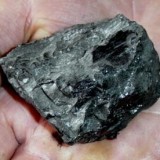What does Port Alberni have in common with Fukushima, Japan – besides a love for fish? Two things, potentially.
First, according to experts from Emergency Management BC, Port Alberni is located in the heart of the most dangerous Tsunami zone in the country, making it prone to a catastrophe like the one we just witnessed across the Pacific. Second, if Compliance Energy gets its way, the town’s harbour will host a dirty energy facility right in the path of the big wave.
Compliance is the proponent for the Raven Underground Coal Mine, near Fanny Bay, on the opposite side of Vancouver Island. The company wishes to truck its coal from there to Port Alberni – passing through Cathedral Grove along the way – to a coal storage facility in the town’s port, before being loaded onto ships carrying the black gunk to China. This week, the first round of environmental assessment public meetings is taking place on the proposed mine and coal port. The first of these, last night in Courtenay, saw over 500 people turn out to deliver a resounding message to representatives of the Canadian and BC Environmental Assessment Offices, opposing the plan.
Unlike the six nuclear reactors at Fukushima, fatally damaged by the recent earthquake and Tsunami, Port Alberni would be home to an 80,000 tonne coal storage facility – with catastrophic economic, ecological and health consequences for the community and region the next time the big one hits.
In 1964, a massive Tsunami unleashed by an earthquake in Alaska swept over the town on the west coast of Vancouver Island, causing $10 million dollars of damage (in 1964 dollars). Historical records show it is not a question of “if” but “when” the next one will come. There will be more significant earthquakes along the Cascadia Subduction Zone and other tectonic hotspots in the Pacific Ocean – and when they occur, there is the distinct possibility of another Tsunami ploughing its way up Alberni Inlet and causing all manner of devastation.
If there is an 80,000 tonne coal container there, the consequences will be unimaginable. Alberni Inlet is home to, among other ecological treasures, one of Canada’s most prominent salmon rivers, the Somass, which has helped the town lay claim over the years to “Salmon Capital of the World” (a bone of contention with my home town of Campbell River, which used to make the same boast).
According to Coal-Free Alberni president Satcey Gaiga, “The coal would potentially be dispersed throughout 600 hectares based on how far the water would reach in our valley, according to our Provincial Emergency Program information…I can’t believe the Environmental Assessment Offices provincially and federally are even considering these preposterous plans, allowing [Compliance Energy] to continue to go through the environmental assessment process to do this: HOW DO YOU MITIGATE A TSUNAMI?”
Indeed, British Columbians must ask their provincial and federal bureaucrats and politicians, “Have we learned nothing from Fukushima and the nuclear waste continues pouring into our Pacific Ocean?”
The environmental assessment hearings resume this Thursday in Port Alberni for what promises to be a fiery round 2. Click here for a complete schedule.
The CEA Agency and the EAO accept public comments submitted by any of the following means:
- By Online Form: www.eao.gov.bc.ca
- By Email: raven@ceaa-acee.gc.ca
- By Fax: 250-356-6448
- By Mail:
Rachel Shaw, Project Assessment Manager
Environmental Assessment Office
PO Box 9426 Stn Prov Govt
Victoria BC V8W 9V1
Or
Andrew Rollo, Project Manager
Canadian Environmental Assessment Agency
320 – 757 West Hastings Street
Vancouver BC V6C 1A1
Click here electronic copy of the draft AIR/EIS Guidelines document and information regarding the environmental assessment process.




